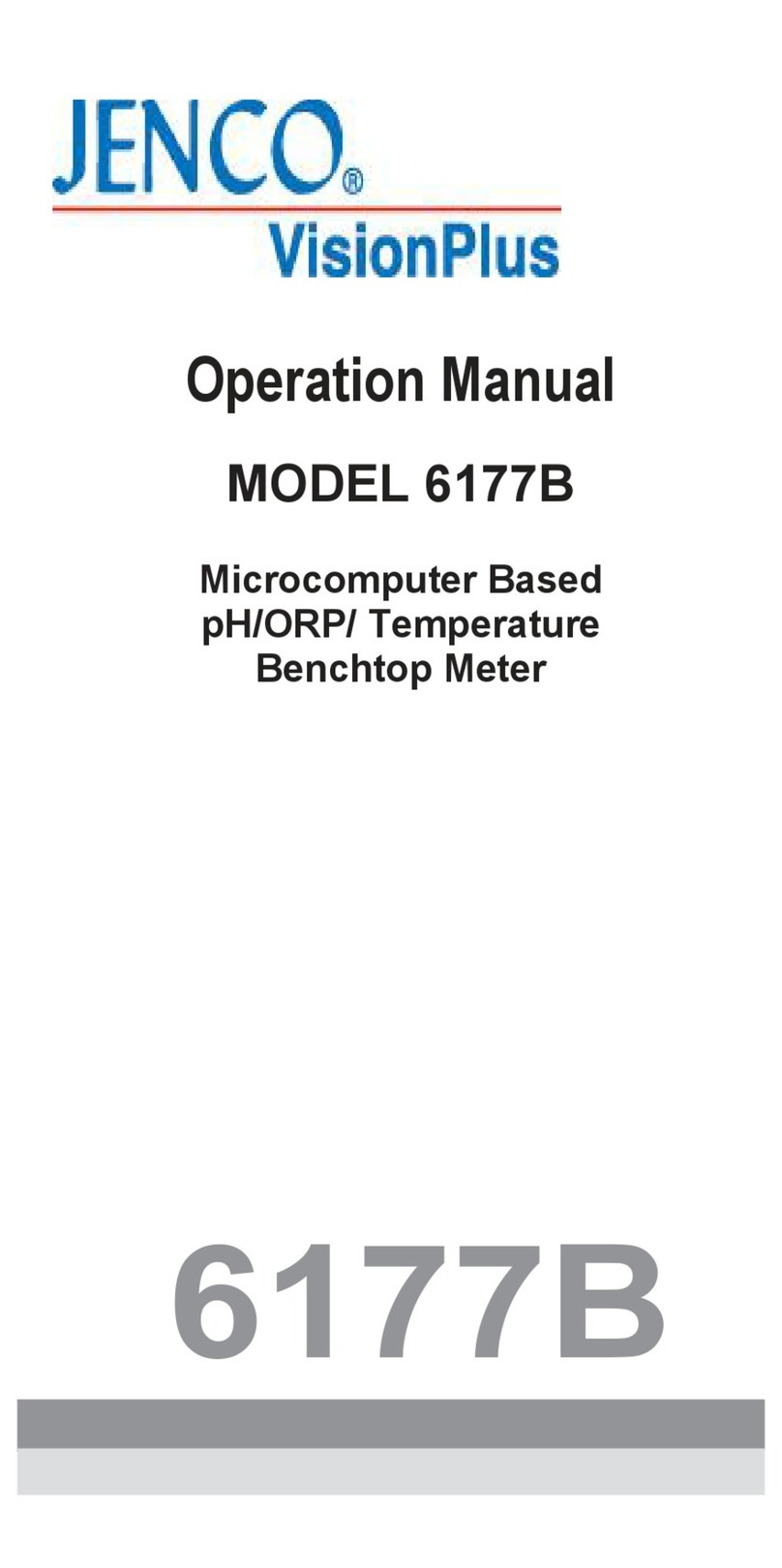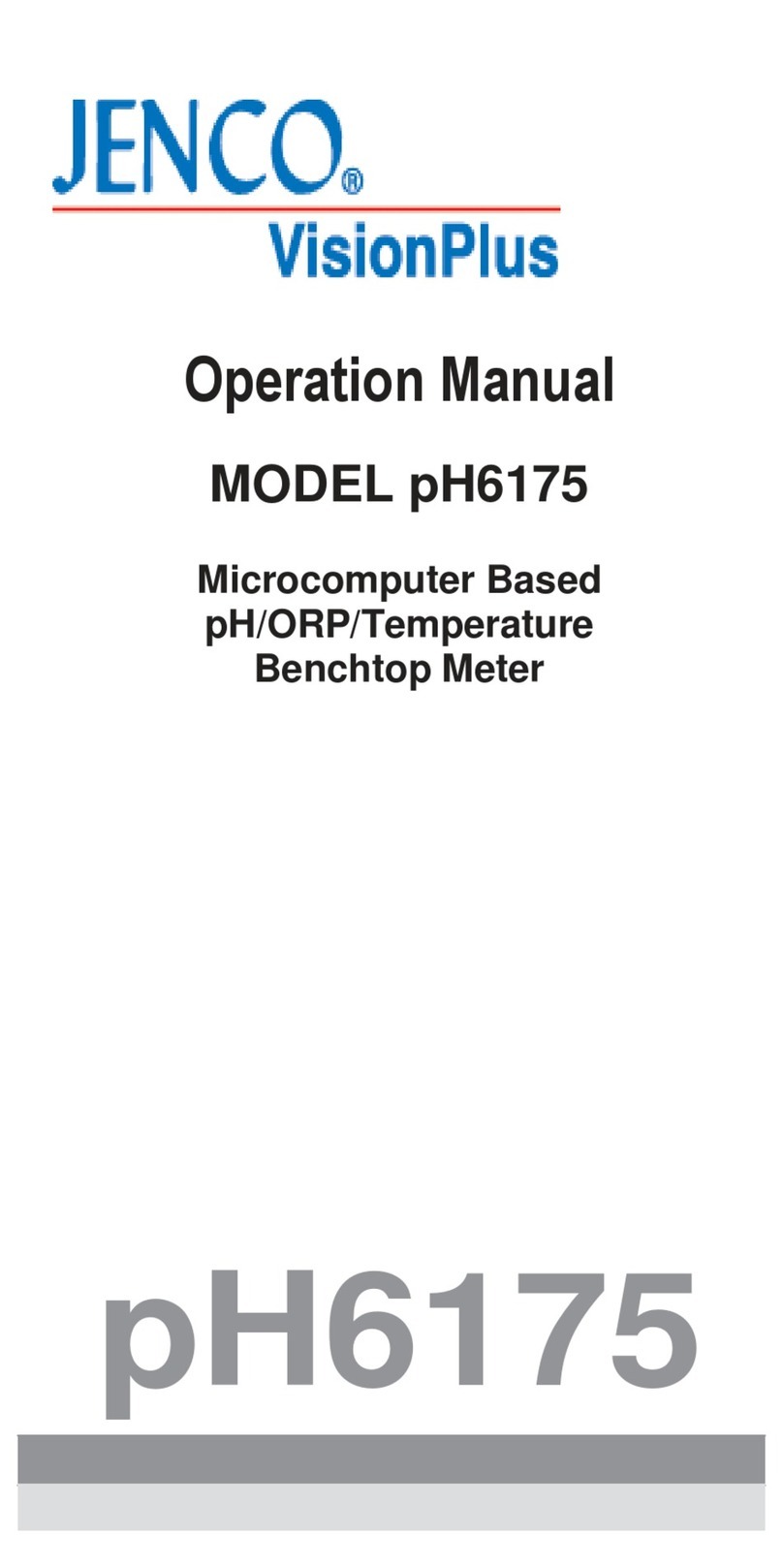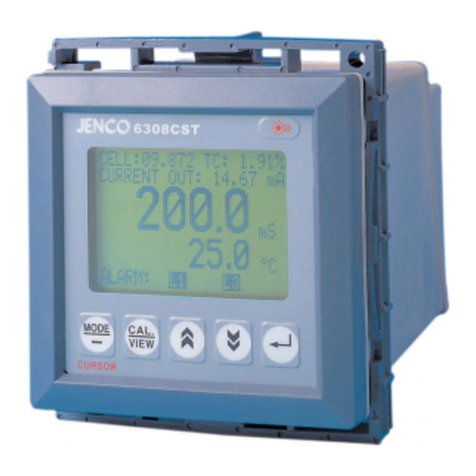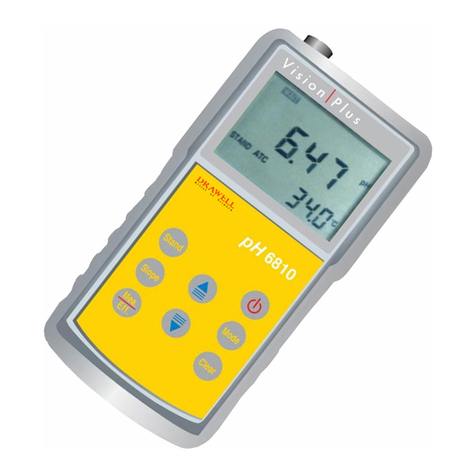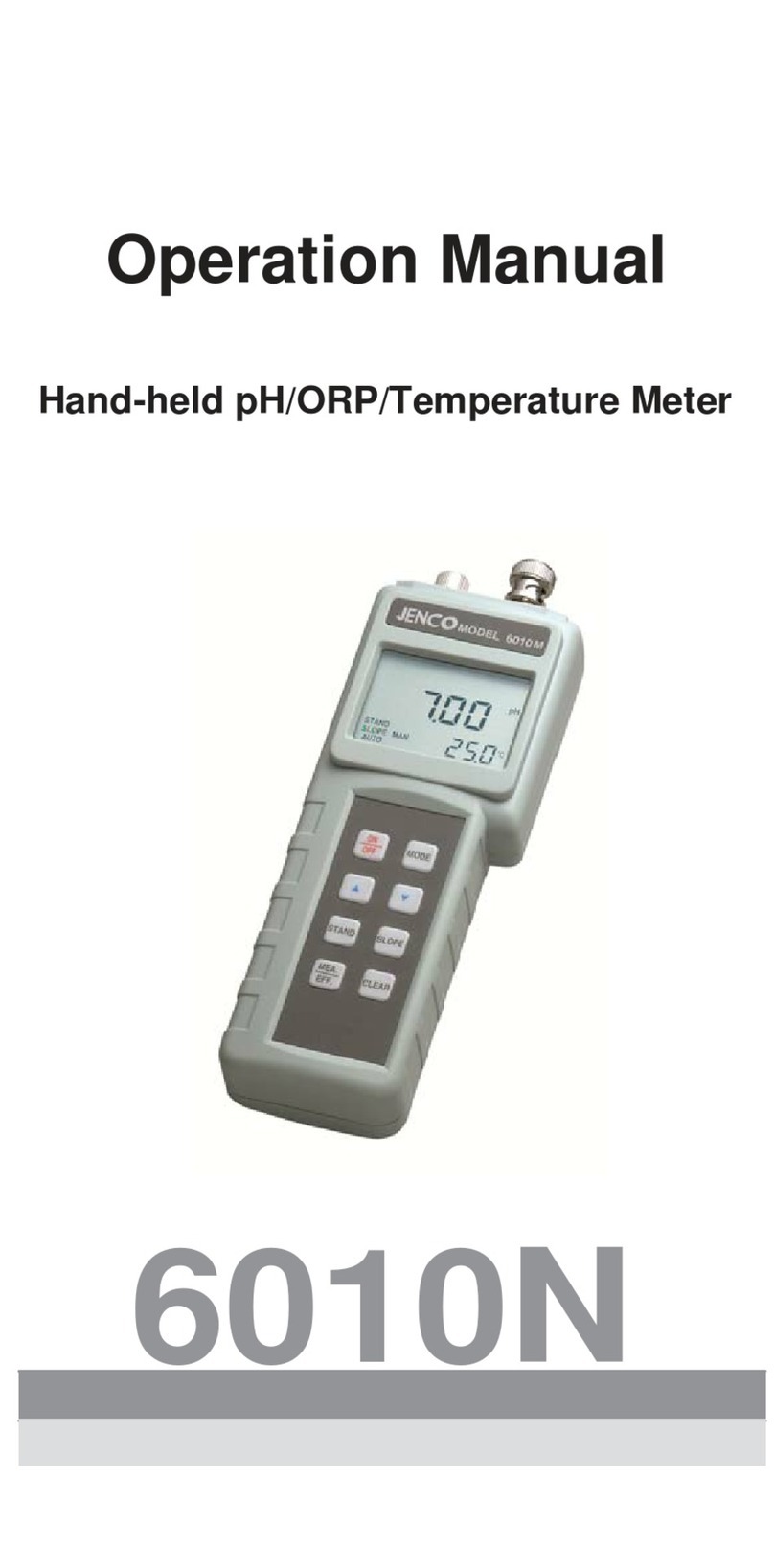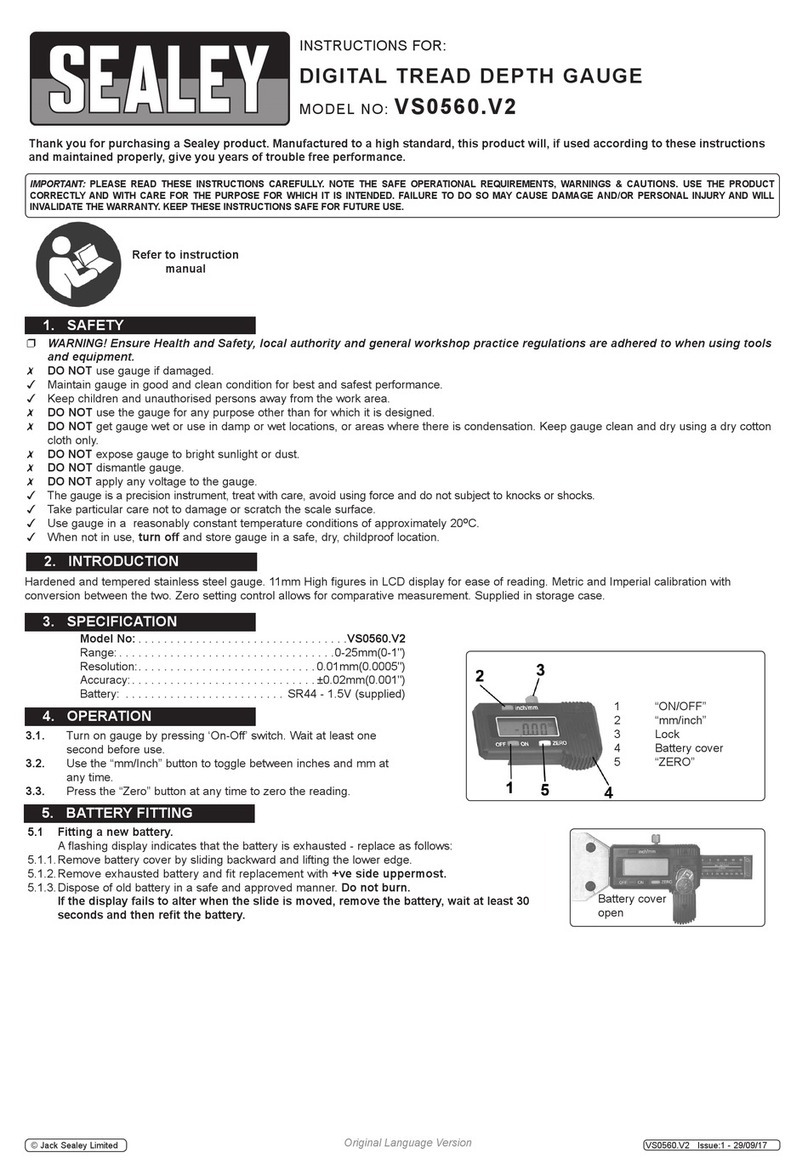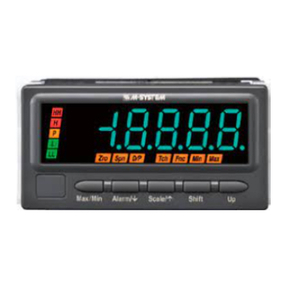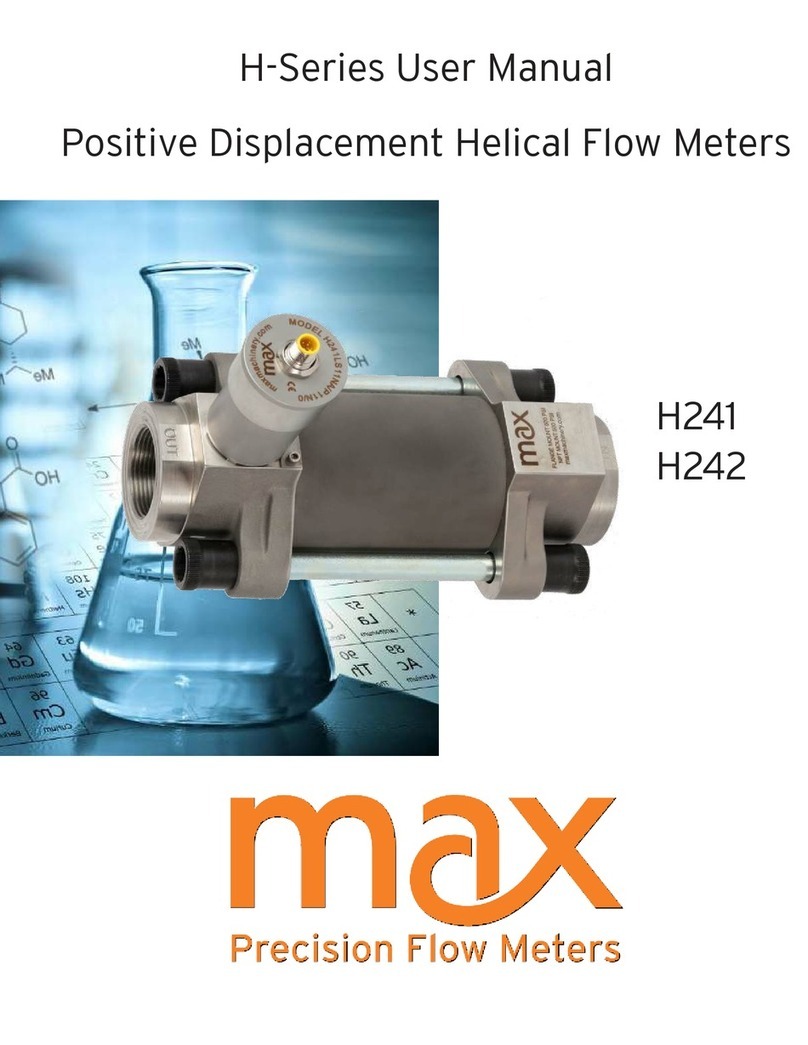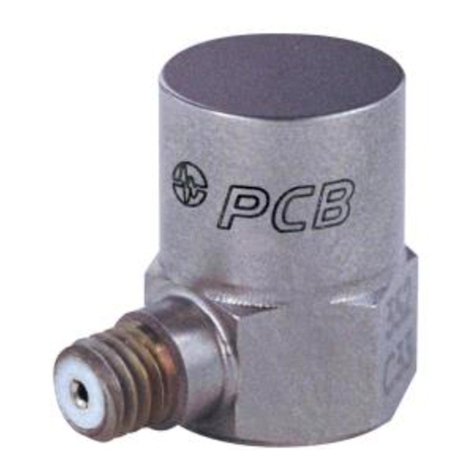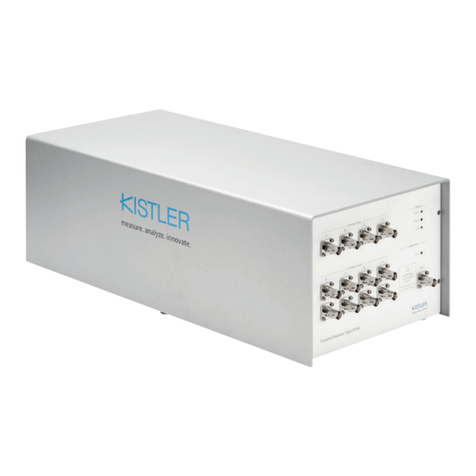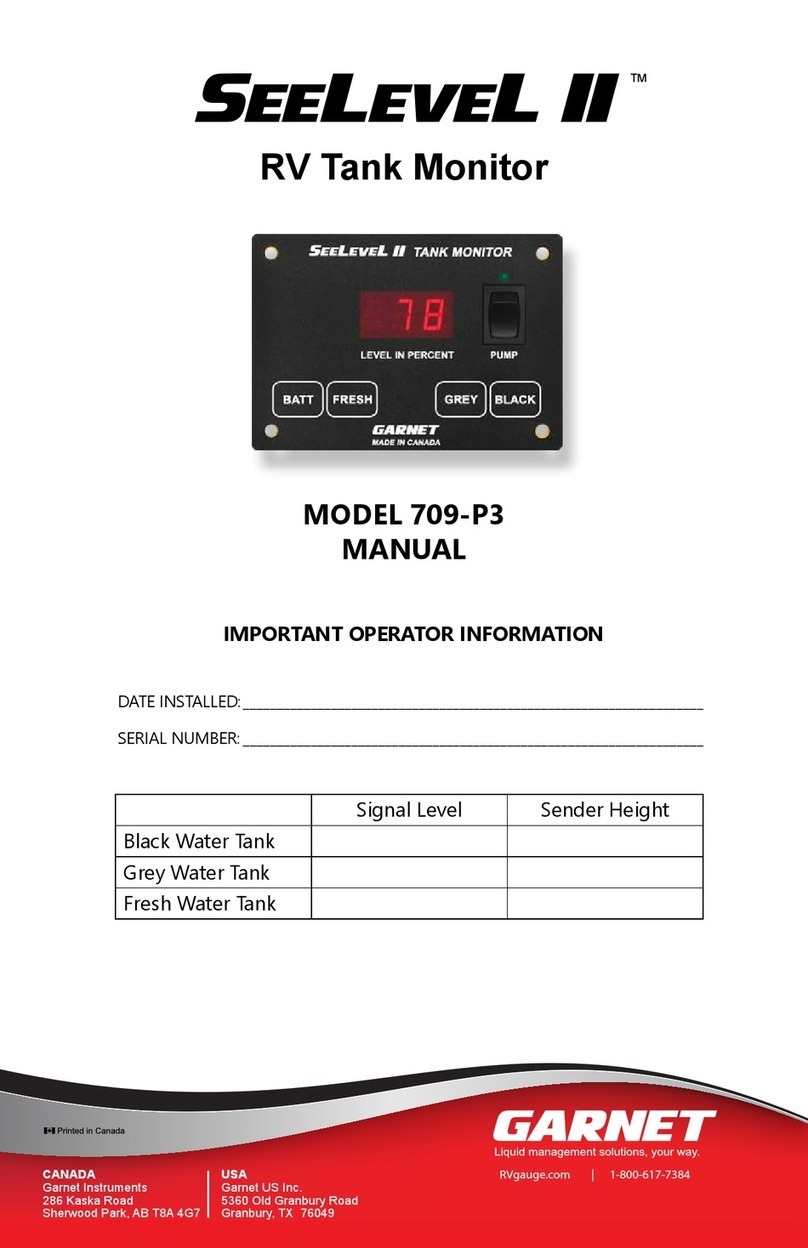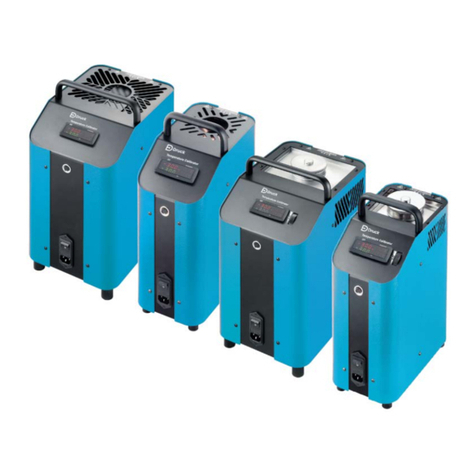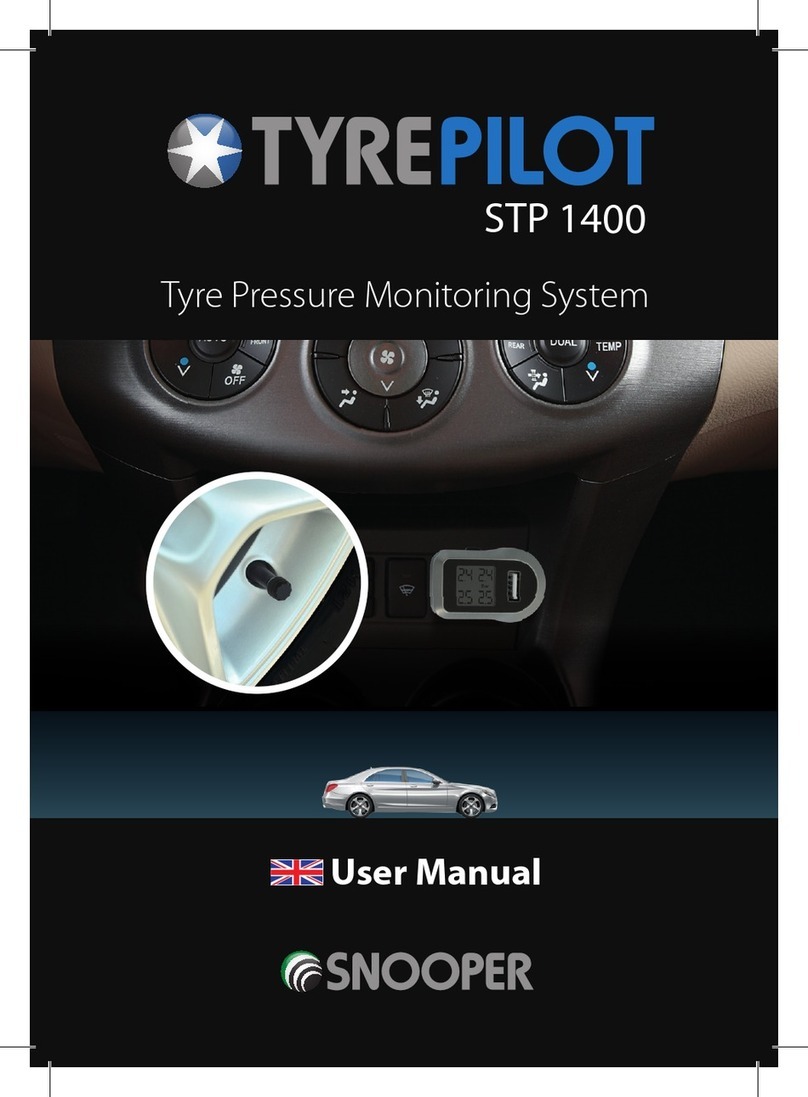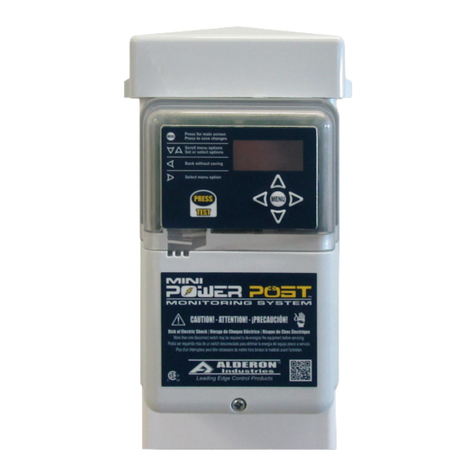JENCO 6179 User manual

Operation Manual
MODEL 6179
Microcomputer Based
pH/ORP/ION/Temperature
Benchtop Meter
6179

1
CONTENTS
GENERAL INTRODUCTION 2
INITIAL INSPECTION 2
POWER INPUT 2
INSTALLING THE BATTERIES 3
CONNECTOR 3
DISPLAY & KEYS FUNCTIONS 4
A. Disp lay 4
B. Ke ys 5
OPERATIONAL PROCEDURES 6
A. Buffer Set Selection 6
B. pH Calibration 6
C. pH Measurements 10
D. Temperature Measurements 11
E. mV offset 11
F. mV (Rmv) Measurements 11
G. Ion Calibration 12
H. Ion Measurements 14
I. Ion Selective Electrodes 15
J. pH Buffers 16
ERROR DISPLAYS AND TROUBLESHOOTING 17
SPECIFICATIONS 18
WARRANTY 19

2
GENERAL INTRODUCTION
Thank you for selecting the 6179 meter. The 6179 is a precision tool
that measures pH, mV, ion concentration and temperature. A built-in
microprocessor stores, calculates and compensates for all
parameters related to pH determinations including pH electrode
temperature characteristics, electrode slope deviations, offset and
buffer solutions.
This meter has a waterproof IP54 case. The mechanical keys are
highly reliable with tactile and audio feedback. It is powered by six
AAA-size alkaline batteries or with a UL/CE approved AC adapter
(OUTPUT:DC 9 V). The meter also displays a “BAT” message when
the batteries are in need of replacement. Re-calibration is not
required when power is restored.
The front of the meter has a large LCD that displays pH , mV , Rmv,
ion and temperature measurements along with user prompts and
mode indicators. The unit prompts the user through calibration and
measurement procedures.
An AUTOLOCK feature for pH, mV (RmV)and ion measurements
enables the unit to automatically sense the end point and “LOCK”
the display to indicate the end point value of a measurement.
AUTOLOCK and user prompts help eliminate most errors in
determining pH, mV (Rmv), ion values, resulting in precise,
repeatable and error-free measurements. The 6179 can also be
used in non-AUTOLOCK mode.
The model 6179 is available with pH, ORP, ion and ATC (Automatic
Temperature Compensation) probes. Other features include up to 5
point calibration for pH , 2 to 5 point calibration for ion, 1 point
calibration for ORP, electrode offset recognition, electrode slope
recognition, electrode efficiency display, built-in buffer coefficients,
automatic or manual temperature compensation and 50/60 Hz AC
noise rejection. This meter is user-friendly for laboratory application.
INITIAL INSPECTION
Carefully unpack the unit and accessories. Inspect for damages
made in shipment. If any damage is found, notify your JENCO
representative immediately. All packing materials should be saved
until satisfactory operation is confirmed.
POWER INPUT
The model 6179 can be powered by an UL/CE approved 100 to 240
VAC adaptor as well as 6 “AAA” alkaline batteries. Check the label
on the AC adaptor supplied with the instrument to make sure that
the AC line voltage is correct. If the wrong AC adaptor is supplied,
notify your JENCO representative immediately.

3
INSTALLING THE BATTERIES
To insert the batteries into the meter, follow the procedure outlined
below.
1. Use a Philip screw driver and unlock the battery cover by
turning the screw driver in the counter clockwise direction.
After unlocking the screw, take off the battery cover (Fig.1)
2. Replace the old batteries with new ones and install them in the
correct polarity position.
3. Put the battery cover back on the instrument. Use a Philip
screw driver and turn the screw in the clockwise direction to
lock the battery cover.
Figure 1: Battery compartment
CONNECTOR
1 2 3
Figure 2: Connector

4
1. pH/ORP/ISE connector(BNC connector)
2. ATC connector (8 PIN connector)
3. AC adaptor input connector
DISPLAY & KEYS FUNCTIONS
A. Display
1
2
3
4
5
6
7
9
10
12
11
81.68 4.01 7.00 10.01
4.00 6.86 9.18 12.46
Figure2: Active LCD screen
1. WAIT-
This will be displayed when the
unit is still waiting for a stable
reading or end point sensing.
7. AUTO-
AUTOLOCK mode indicator.
2. BAT-
Low battery indicator.
8. Buffer selection-
This indicator will flash if the
unit is not yet calibrated. This
indicator will remain lit-up if
the unit has been calibrated.
3. pH-
Unit and mode indicators.
9. LOCK-
This will indicate that the
reading is frozen during
AUTOLOCK mode.
4. mV (RmV)-
Unit and mode indicators.
10. EFF-
This will be displayed if the
user is viewing the efficiency
of the electrode.
5. ATC/MAN-
ATC indicator will be displayed
if a temperature probe is
connected otherwise the MAN
indicator will be displayed.
11. MAIN DISPLAY-
For pH, mV (RmV), ion and
probe efficiency values

5
6. CAL-
This will be displayed when the
unit enters into the calibration
mode.
12. SECONDARY DISPLAY-
For temperature in ℃.
B. Keys
Mea.
Eff.
Stand
Slope
Mode
Clear
On/Off-
Press and hold this key for 2 seconds to power on
and shut off the meter.
Mea.
Eff.
Stand
Slope
Mode
Clear
Mode-
1. Select display mode. Pressing this key changes
the display sequentially to display pH-AUTOLOCK,
mV (RmV)-AUTOLOCK, ION-AUTOLOCK, pH, mV
(RmV) and ion. The calibration values will not be
affected by changing the display modes.
2. In calibration mode, press “Mode” key to exit
calibration mode.
Set
Set-
1. In pH mode, press the “Set” key to enter the
buffer set selection screen.
2. In mV (Rmv) mode, press the “Set” key to enter
the hold/clear selection.
3. In ion mode, press the “Set” key to enter the
calibration point selection mode.
Mea.
Eff.
Stand
Slope
Mode
Clear
Mea.
Eff.
Stand
Slope
Mode
Clear
Up & Down-
1. In the pH/ORP/ION measure mode, these two
keys are used to manually enter the temperature
values. They have no effect on the unit when
operating in ATC mode.
2. In the ORP calibration mode, these two keys are
used to adjust the RmV display value. In the ion
calibration mode, these two keys are used to
select first point calibration value.
3. In the SET mode, these two keys are used to
choose the corresponding settings.
Stand
Slope
Enter
Stand & Slope/Enter-
1. These two keys are used for pH, ORP and ion
calibration. For their specific functions, please see
the "calibration" section in each parameter.
2. In SET mode, the “Slope/Enter” key is used
to save the corresponding parameter selected.

6
Mea.
Eff.
Mea./Eff.-
1. The key is used to bring the unit out of the
AUTOLOCK condition when operating in the
pH-AUTOLOCK, mV (RmV) - AUTOLOCK or
ion-AUTOLOCK mode.
2. In the pH or ion measure mode, press and hold
this key for 5 seconds, the LCD will display the
efficiency of the electrode and the offset value.
3. In the ORP measure mode, press and hold this
key for 5 seconds, the LCD will display the offset
value of the electrode.
OPERATIONAL PROCEDURES
A. pH Buffer Set Selection
The 6179 meter has two buffer sets: 1.68, 7.00, 4.01, 10.01,
12.46 pH and 1.68, 6.86, 4.00, 9.18, 12.46 pH.
In pH mode, press “Set” to enter the buffer set selection mode.
Use “Up” or “Down” to select the preferred buffer set. Press
“Slope/Enter” to save the selected buffer set.
[Note: There is no need to repeat this procedure every time the
unit is power up unless one decides to change the buffer
settings.]
B. pH Calibration
The 6179 uses up to 5 point calibration.
[Note: If the device is required to perform more than one
calibration points, the first calibration point must be 6.86/7.00
pH.]
a. Calibration with an ATC/Temp probe in the pH-AUTOLOCK
mode.
1. Turn the unit on. In pH-AUTOLOCK mode, press “Set” to
enter the buffer set selection mode. Use the “Up” or “Down”
to select the preferred buffer set. Press “Slope/Enter” to
save the selected buffer set and enter into the hold/clear
selection screen. Use “Up” or “Down” to select “CLr”. Press
“Slope/Enter”. The meter will clear all previously stored
calibration values and is now ready for fresh calibration.
2. Connect the pH electrode to the BNC connector and the
ATC/Temp probe to the ATC/Temp connector of the meter.
The “ATC” icon will lit up. The “pH” and “AUTO” icons will also
lit up. The "CAL" icon begins to flash. The meter is now ready

7
for calibration.
3. Rinse the pH and ATC/Temp probes in distilled water and
immerse them in the first buffer solution (to perform 2 to 5
point calibration, the first calibration point must be 6.86/7.00).
Allow temperature reading to stabilize. Press and hold
“Stand” for 2 seconds to start calibration. The “WAIT” icon
will flash unit the meter detects a stable reading. Once the
meter calibrated the first point, the selected buffer icon will lit
up while two other selectable buffer icons start to flash. One
point calibration is now complete. Press “Mode” to exit.
4. To continue with the second point calibration, rinse the pH
and ATC/Temp probe in distilled water and immerse them in
the second buffer solution (either 4.00/4.01 pH or 9.18/10.01
pH corresponding to the flashing number on display). Allow
temperature reading to stabilize. Press “Slope/Enter”. The
“WAIT” icon will flash until the meter detects a stable reading.
Once the meter calibrated the second point, the selected
icons of the two buffers lit up and the remaining buffer starts
to flash. Dual point calibration is now complete. Press
“Mode” to exit.
5. To continue with the third, the fourth and the fifth point
calibration, repeat step 4. Press “Mode” to exit calibration
mode when the desired calibration points are completed.
6. The unit calculates and compensates for the pH electrode
slope deviation corresponding to the values of the calibrated
buffers. After calibration, press and hold “Mea./Eff.-” for
about 5 seconds to display the new electrode efficiency and
offset.
b. Calibration with manual temperature compensation in the
pH-AUTO LOCK mode.
1. Turn the unit on. In pH-AUTOLOCK mode, press “Set” to
enter the buffer set selection mode. Use “Up” or “Down” to
select the preferred buffer set. Press “Slope/Enter” to save
the selected buffer set and enter the hold/clear selection
screen. Use “Up” or “Down” to select “CLr”. Press
“Slope/Enter”. The meter will clear all previously stored
calibration values and is now ready for fresh calibration.
2. Connect the pH electrode to the BNC connector of the meter,
the “MAN” icon will lit up. The “pH” and “AUTO” icons will also
lit up. The "CAL" icon will begin to flash. The meter is now
ready for calibration.
3. Rinse the pH probes in distilled water and immerse it in the
first buffer solution (to perform 2 to 5 point calibration, the first

8
calibration point must be 6.86/7.00). Adjust the temperature
reading to that of the first buffer using “Up” or “Down” (0.0 to
60.0 ℃). Then press and hold “Stand” for 2 seconds to
calibrate. The “WAIT” icon will flash until the unit detects a
stable reading.
4. Once the unit calibrated the first point, the selected buffer
remains lit up while two other selectable buffers start to flash.
One point calibration is now complete. Press “Mode” to exit.
5. Repeat steps 4 and 5 of “Calibration with an ATC/Temp
probe in the pH-AUTOLOCK mode” for 2 to 5 point
calibration. Press “Mode” to exit calibration mode when the
desired calibration points are complete.
6. The unit calculates and compensates for the pH electrode
slope deviation corresponding to the values of the calibrated
buffers. After calibration, press and hold “Mea./Eff.-” for
about 5 seconds to display the new electrode efficiency and
offset.
c. Calibration with an ATC/Temp probe in the pH NON-
AUTOLOCK mode.
1. Turn the unit on. In pH NON-AUTOLOCK mode, press “Set”
to enter the buffer set selection mode. Use “Up” or “Down”
to select the preferred buffer set. Press “Slope/Enter” to
save the selected buffer set and enter the hold/clear selection
screen. Use the “Up” or “Down” to select “CLr”. Press
“Slope/Enter”. The meter will clear all previously stored
calibration values and is now ready for fresh calibration.
2. Connect the pH electrode to the BNC connector and the
ATC/Temp probe to the ATC/Temp connector of the meter.
The “ATC” and “pH” icons will lit up. The "CAL" icon will begin
to flash. The meter is now ready for calibration.
3. Rinse the pH and ATC/Temp probes in distilled water and
immerse them in the first buffer solution (to perform 2 to 5
point calibration, the first calibration point must be 6.86/7.00).
Allow temperature reading to stabilize. Press and hold
“Stand” for 2 seconds. The unit immediately calibrates the
first point. The selected buffer icon remains lit up while two
other selectable buffer icons start to flash. One point
calibration is now complete. Press “Mode” to exit.
4. To continue with the second point calibration, rinse the pH
and ATC/Temp probe in distilled water and immerse them in
the second buffer solution (either 4.00/4.01 pH or 9.18/10.01
pH corresponding to the flashing number on display). Allow

9
temperature reading to stabilize. Press “Slope/Enter”. The
unit immediately calibrates the second point, The selected two
buffers lit up and the remaining buffer icons start to flash. Dual
point calibration is now complete. Press “Mode” to exit.
5. To continue with the third, the fourth and the fifth point
calibration, repeat step 4. Press “Mode” to exit calibration
mode when the desired calibration points are completed.
6. The unit calculates and compensates for the pH electrode
slope deviation corresponding to the values of the calibrated
buffers. After calibration, press and hold “Mea./Eff.-” for about
5 seconds to display the new electrode efficiency and offset.
d. Calibration with manual temperature compensation in the
pH NON-AUTOLOCK mode.
1. Turn the unit on. In pH-NON-AUTOLOCK mode, press “Set”
to enter the buffer set selection screen. Use “Up” or “Down”
to select the preferred buffer set. Press “Slope/Enter” to save
the selected buffer set and enter into the hold/clear selection
screen. Use “Up” or “Down” to select “CLr”. Press
“Slope/Enter”. The meter will clear all previously stored
calibration values and is now ready for fresh calibration.
2. Connect the pH electrode to the BNC connector of the unit,
“MAN” and “pH” icons will lit up. The "CAL" icon will begin to
flash. The meter is now ready for calibration.
3. Rinse the pH probes in distilled water and immerse it in the
first buffer solution (to perform 2 to 5 point calibration, the first
calibration point must be 6.86/7.00). Adjust the temperature
reading to that of the first buffer using “Up” or “Down” (0.0 to
60.0 ℃). Then press and hold “Stand” for 2 seconds to
calibrate. The unit immediately calibrates the first point, The
selected buffer icon remains lit up while the remaining buffer
icons start to flash. One point calibration is now complete.
Press “Mode” to exit.
4. Repeat steps 4 of “Calibration with an ATC/Temp probe in
the pH NON- AUTOLOCK mode” for 2 to 5 point calibration.
Press “Mode” to exit calibration mode when the desired
calibration points are complete.
5. The unit calculates and compensates for the pH electrode
slope deviation corresponding to the values of the calibrated
buffers. After calibration, press and hold “Mea./Eff.-” for
about 5 seconds to display the new electrode efficiency and
offset.

10
C. pH Measurements
To take pH measurements, 6179 must be calibrated before first
use.
a. Measurement with an ATC/Temp probe in the pH-
AUTOLOCK mode.
1. Connect the pH electrode to the BNC connector and the
ATC/Temp probe to the ATC/Temp connector of the meter.
The “ATC” icon will lit up.
2. Press “Mode” until the “pH” and “AUTO” icons lit up.
3. Rinse the pH electrode and ATC/Temp probe with distilled
water and immerse in the sample to be measured. Remove
any air bubbles trapped around the probe by shaking or
stirring the probe.
4. Press the “Mea./Eff.-”. The “WAIT” icon will start to flash. The
unit is waiting for a stable reading. The display will track the pH
value as sensed by the pH electrode and the ATC/Temp
probe.
5. When the “WAIT” icon disappears, the reading is then “LOCK”
and will not respond to further changes from the sample. The
pH value shown is the pH value of the sample at the displayed
sample temperature.
[Note: For samples that are inherently unstable, the unit will
not AUTOLOCK. In this case, use the pH NON- AUTOLOCK
mode for measurements.]
b. Measurement with manual temperature compensation in
the pH-AUTOLOCK mode.
1. Connect the pH electrode to the BNC connector of the meter.
The “MAN” icon will lit up. Set unit to display the sample
temperature by pressing “Up” and “Down” (0.0 to 100.0 ℃).
2. Repeat steps 2 to 5 of “Measurement with an ATC/Temp
probe in the pH- AUTOLOCK mode”.
c. Measurement with an ATC/Temp probe in the pH NON-
AUTOLOCK mode.
1. Connect the pH electrode to the BNC connector and the
ATC/Temp probe to the ATC/Temp connector of the meter.
The “ATC” icon will lit up.
2. Press “Mode” until “pH” icon lit up.

11
3. Rinse the pH electrode and ATC/Temp probe with distilled
water and immerse in the sample to be measured.
4. Allow sufficient time for the display to stabilize. The meter will
display the pH value of the sample at the displayed sample
temperature.
d. Measurement with manual temperature compensation in
the pH NON-AUTOLOCK mode.
1. Connect the pH electrode to the BNC connector of the meter.
The “MAN” icon will lit up. Set meter to display the sample
temperature by using “Up” and “Down” (0.0 to 100.0 ℃).
2. Repeat steps 2 to 4 of “Measurement with an ATC/Temp
probe in the pH NON- AUTOLOCK mode”.
D. Temperature Measure
The 6179 can measure temperature independently with the
ATC/Temp probe without using the pH electrode. Place the
ATC/Temp probe in the sample. The unit will display the
measured temperature.
E. mV Offset
1. Turn the unit on. In mV (Rmv) mode. Press “Set” to enter the
hold/clear selection screen. Use “Up” or “Down” to select
“CLr”. Press “Slope/Enter”. The meter will clear all
previously stored calibration values and is now ready for
fresh calibration.
2. Connect the ORP electrode to the BNC connector of the unit.
The “MAN”, “mV” and “AUTO” icons will lit up.
3. Rinse the ORP probe in distilled water and immerse it in the
standard solution. Then press and hold “Stand” for 2
seconds to calibrate. The “CAL” & “RmV” icons will lit up.
According to the mV (RmV) value displayed, use the “Up”
and “Down” keys to adjust the display value to the same
value as the standard solution. Press “Slope/Enter” to save
and complete the calibration.
F. mV (RmV) Measurements
a. Measurement in the mV (RmV)-AUTOLOCK mode.
1. Connect the ORP electrode to the BNC connector of the unit.
2. Press “Mode” until “mV” or “RmV” icon and “AUTO” icon lit
up.

12
3. Rinse electrode with distilled water and immerse it in sample to
be measured.
4. Press “Mea./Eff.-”. The “WAIT” icon will start to flash. The unit
is waiting for a stable reading. The display will track the mV
(Rmv) value as sensed by the ORP electrode.
5. When the “WAIT” icon disappears, the reading is then “LOCK”
and will not respond to further changes from the sample. The
mV (RmV) value is the sample reading.
[Note: For samples that are inherently unstable, the unit will
not AUTOLOCK. In this case, use the mV (RmV) NON-
AUTOLOCK mode for measurements.]
b. Measurement in the mV (RmV) NON-AUTOLOCK mode.
1. Connect the ORP electrode to the BNC connector of the unit.
2. Press “Mode” until “mV” or “RmV” icon lit up.
3. Rinse electrode with distilled water and immerse it in sample to
be measured.
4. Allow sufficient time for the display to stabilize. The instrument
will display the mV (RmV) value of the sample.
G. ION Calibration
The 6179 can measure ion concentration when using an
ion selective electrode (ISE) for the specific ion of interest.
The available ion calibration values are 0.10, 1.0, 10.0,
100.0, and 1000. Choose a minimum of 2 consecutive
values for calibration and prepare the corresponding ion
calibration solutions. For best results always begin with the
lowest standard value, followed by the next lowest standard.
The 6179 uses 2 to 5 point calibration.
a. Calibration in the ION-AUTOLOCK mode.
1. Turn the unit on. In ION-AUTOLOCK mode, press the “Set” to
enter the calibration point selection screen. Use “Up” or
“Down” to select 2 to 5 point calibration.
2. Press “Slope/Enter” to enter the monovalent ion/divalent ion
selection screen. Use “Up” or “Down” to select.
3. Press “Slope/Enter” to enter the hold/clear selection screen.
Use “Up” or “Down” to select “CLr”. Press “Slope/Enter”.
The meter will clear all previously stored calibration values and

13
is now ready for a fresh calibration.
4. Connect the ISE to the BNC connector of the meter. “MAN”
and “AUTO” icons will lit up. The "CAL" icon will begin to
flash.
5. Rinse the ISE in distilled water and immerse it in the first
standard solution. Press and hold “Stand” for 2 seconds to
calibrate. The “CAL” & “AUTO” icons will lit up. The main
display will show “- - - -”, the secondary display will show
corresponding ion calibration value (0.10, 1.0, 10, 100) . Use
“Up” or “Down” to select the first point calibration value.
6. Press “Slope/Enter”. The mV value of the standard solution
will appear on the main display. The “Wait” icon will flash until
the meter detects a stable value. When the “Wait” icon
disappears and the ion calibration value on the secondary
screen moves up to the next value, the first point calibration is
complete and the meter is ready for the second point
calibration.
7. Rinse the ISE in distilled water and immerse it in the second
standard solution. Press “Slope/Enter”. The “Wait” icon will
flash until the meter detects a stable reading. When the “Wait”
icon disappears and the ion calibration value on the secondary
screen moves up to the next value, the second point
calibration is complete and the meter is ready for the third point
calibration.
8. To continue with the third, the fourth and the fifth point
calibration, repeat step 7. Press “Mode” to exit calibration
mode when the desired calibration points are completed.
[Note: The slope (mV difference between two consecutive
points) is 15 to 90 mV.]
b. Calibration in the ION-NON-AUTOLOCK mode.
1. Turn the unit on. In ION-NON-AUTOLOCK mode, press the
“Set” to enter the calibration selection screen. Use “Up” or
“Down” to select 2 to 5 point calibration.
2. Press “Slope/Enter” to save and enter the monovalent ion or
divalent ion selection screen. Use “Up” or “Down” key to
select.
3. Press “Slope/Enter” to enter the hold/clear selection screen.
Use “Up” or “Down” to select “CLr”. The meter will clear all
previously stored calibrated values and is now ready for fresh
calibration.
4. Connect the ISE to the BNC connector of the unit. The “MAN”

14
icon will lit up. The "CAL" icon will begin to flash.
5. Rinse the ISE in distilled water and immerse it in the first
standard solution. Press and hold “Stand” for 2 seconds.
The “CAL” icon will lit up. The main display will show “- - - -”
and the secondary display will show corresponding ion
calibration value (0.10, 1.0, 10, 100). Use “Up” or “Down” to
select first point calibration value.
6. Press “Slope/Enter”. The mV value of the standard solution.
When the MV value of the standard solution is stable, press
“Slope/Enter" to save. The ion calibration value on the
secondary screen moves up to the next value. The first point
calibration is complete and the meter is ready for the second
point calibration.
7. Rinse the ISE in distilled water and immerse it in the second
standard solution. When the MV value of the standard solution
is stable, press “Slope/Enter" to save. The ion calibration
value on the secondary screen moves up to the next value.
The second point calibration is complete and the meter is
ready for the third point calibration.
8. To continue with the third, the fourth and the fifth point
calibration, repeat step 7. Press “Mode” to exit calibration
mode when the desired calibration points are completed.
[Note: The slope (mV difference between two consecutive
points) is 15 to 90 mV.]
H. ION Measurements
a. Measurement in the ION-AUTOLOCK mode.
1. Connect the ISE to the BNC connector of the unit.
2. Press “Mode” until “AUTO” and “MAN” icons lit up.
3. Rinse electrode with distilled water and immerse it in sample to
be measured.
4. Press the “Mea./Eff.-”. The “WAIT” icon will start to flash. The
unit is waiting for a stable reading. The display will track the ion
value as sensed by the ion selective electrode.
5. When the “WAIT” icon disappears, the reading is then “LOCK”
and will not respond to further changes from the sample. The
ion value is the sample reading.
[Note: For samples that are inherently unstable, the unit will
not AUTOLOCK. In this case, use the ION NON- AUTOLOCK

15
mode for measurements.].
b. Measurement in the ION NON-AUTOLOCK mode.
1. Connect the optional combination ion selective electrode to the
BNC connector of the unit.
2. Press “Mode” until the “MAN” icon lit up.
3. Rinse electrode with distilled water and immerse it in sample to
be measured.
4. Allow sufficient time for the display to stabilize. The instrument
will display the ion value of the sample.
I. Ion Selective Electrodes
The table below lists the most common electrodes available.
Ammonia (NH3)
Iodide (I-)
Ammonium (NH4+)
Lead (Pb+2)
Bromide (Br-)
Lithium (Li+)
Cadmium (Cd+2)
Nitrate (NO3-)
Calcium (Ca+2)
Nitrogen Oxide (NOx)
Carbon Dioxide (CO2)
Perchlorate (CIO4-)
Chloride (Cl-)
Potassium (K+)
Copper (Cu+2)
Silver / Sulfide (Ag+/ S-2)
Cyanide (CN-)
Sodium (Na+)
Fluoride (F-)
Surfactant (X+, X-)
Fluoroborate (BF4-)
Water Hardness

16
J. pH Buffers
The temperature coefficient of pH calibration buffers 1.68, 4.00,
4.01, 6.86, 7.00, 9.18 , 10.01 and 12.46 pH are stored inside
the instrument. The buffers used to calibrate the instrument
must exhibit the same temperature characteristics as the
stored values.
Temperature coefficient of the pH buffers
°C
1.68
4.00
6.86
9.18
4.01
7.00
10.01
12.46
0
1.67
4.01
6.98
9.46
4.01
7.11
10.32
13.42
5
1.67
4.00
6.95
9.39
4.01
7.08
10.25
13.21
10
1.67
4.00
6.92
9.33
4.00
7.06
10.18
13.01
15
1.67
4.00
6.90
9.28
4.00
7.03
10.12
12.80
20
1.68
4.00
6.88
9.23
4.00
7.01
10.06
12.64
25
1.68
4.00
6.86
9.18
4.01
7.00
10.01
12.46
30
1.68
4.01
6.85
9.14
4.01
6.98
9.97
12.30
35
1.69
4.02
6.84
9.10
4.02
6.98
9.93
12.13
40
1.69
4.03
6.84
9.07
4.03
6.97
9.89
11.99
45
1.70
4.04
6.83
9.04
4.04
6.97
9.86
11.84
50
1.71
4.06
6.83
9.02
4.06
6.97
9.83
11.71
55
1.72
4.07
6.83
8.99
4.08
6.97
9.80
11.57
60
1.72
4.09
6.84
8.97
4.10
6.98
9.78
11.45
[Note: The actual reading of the instrument can differ from the
values shown by ±0.01 pH ]

17
ERROR DISPLAYS AND TROUBLESHOOTINGG
Main
Display
Possible cause(s)
Corrective Action(s)
"Er1"
1. “Stand” was pressed
before the electrode and
ATC/Temp probe settled to
within +/-1.00 pH of the
buffer value.
2. pH electrode offset is
greater/less than +/-1.00
pH.
3. pH electrode is faulty.
1. Clearing the previous
calibration data. Allow
sufficient time for the
electrode and ATC/Temp
probe to stabilize, recalibrate
meter.
2. Replace the buffer and/or
the pH electrode.
Recalibrate meter.
3. Replace electrode.
"Er2"
1. “Slope” was pressed
before the electrode and
ATC/Temp probe settled to
within 30% of the buffer
value.
2. Buffer 1.68, 4.00, 4.01,
9.18, 10.01 and 12.46 pH
is not correct.
3. pH electrode slope is off by
more than 30% of ideal
slope.
1. Allow sufficient time for the
electrode and ATC/Temp
probe to stabilize, re-press
“Slope/Enter” key to
continue the calibration
procedure.
2. Check if the correct buffer is
used.
3. Clear the previous
calibration data. Replace the
buffer and/or the pH
electrode. Recalibrate meter.
"Er3"
In pH calibration mode,
temperature is out of the
0.0 to 60.0 °C range.
Bring the pH buffer
temperature within range.
“Er4”
In ion calibration mode, the
slope (mV difference
between two consecutive
points) is out of the 15 to
90 mV range.
1. Replace the standard
solution and/or the ISE.
2. Recalibrate meter.
“Er5”
In ion calibration mode, the
end user exited the
calibration mode before
completing the number of
pre-selected calibration
points.
Recalibrate meter.
"over"/
“undr”
1. Measured pH is out of the
-2.00 to 16.00 pH range.
2. Measured mV (RmV) is out
of the –1999.9 to 1999.9
mV range.
3. Measured ion is out of the
0 to 2000 range.
4. Measured temperature is
out of the 0.0 to 100.0 °C
range.
1. Bring sample pH into the
correct measuring range.
2. Bring sample ORP into the
correct measuring range.
3. Bring sample ion into the
correct measuring range.
4. Bring sample temperature
into the correct measuring
range.

18
[Note: If the meter still does not perform normally after the above
measures are taken, call JENCO representative.]
SPECIFICATIONS
Display
Range
Resolution
Accuracy
pH
-2.00 to 16.00 pH
0.01 pH
±0.01 pH
mV (RmV)
-1999.9 to 1999.9 mV
0.1 mV
±0.05% F.S.
Ion
0.01 to 2000
0.01, 0.1, 1
±0.5% F.S.
(mono-valent)
±1.0% F.S.
(di-valent)
Temperature
0.0 to 100.0 °C
0.1 °C
±0.2 °C
pH buffer recognition
1.68, 7.00, 4.01, 10.01,12.46
pH or 1.68, 6.86, 4.00, 9.18,
12.46 pH
pH Temperature compensation
AUTO/MAN 0.0 to 100.0 °C
pH Buffer Temperature range
0 to 60.0 °C
pH calibration
Up to 5 points
ORP calibration
1 point. Offset ±150 mV
Ion calibration
2 to 5 consecutive points,
0.1, 1.0, 10.0, 100.0 or 1000
Input impedance
>3 x 1012
Ω
Temperature sensor
Thermistor, 10 k
Ω
at 25 °C
Power
6 X 1.5 V AAA Batteries or
100 to 240 VAC adapter
Calibration Back-up
EEPROM
Audio Feedback
All Touch Keys
End Point Sensing & Hold
Yes
Screen
Segment LCD backlight
Ambient Temperature Range
0 to 50 °C
Relative Humidity
Up to 90%
Case
IP54
Dimensions (W x D x H)
150 x 210 x 45 mm
Weight
430 grams

19
WARRANTY
JENCO warrants this product to be free from significant deviations
in material and workmanship for a period of 1 year from date of
purchase. If repair or adjustment is necessary and has not been
the result of abuse or misuse, within the year period, please
return-freight-prepaid and the correction of the defect will be made
free of charge. If you purchased the item from our JENCO
distributors and it is under warranty, please contact them to notify
us of the situation. JENCO Service Department alone will
determine if the product problem is due to deviations or customer
misuse.
Out-of-warranty products will be repaired on a charge basis.
RETURN OF ITEMS
Authorization must be obtained from one of our representatives
before returning items for any reason. When applying for
authorization, have the model and serial number handy, including
data regarding the reason for return. For your protection, items
must be carefully packed to prevent damage in shipment and
insured against possible damage or loss. JENCO will not be
responsible for damage resulting from careless or insufficient
packing. A fee will be charged on all authorized returns.
NOTE: JENCO reserves the right to make improvements in
design, construction and appearance of our products without
notice.
Jenco Instruments, Inc.
7968 Arjons Drive, Suite C
San Diego, CA 92126 USA
TEL: 858-578-2828
FAX: 858-578-2886
Website: www.JENCOi.com
Jenco Electronics, Ltd.
6F., NO. 81, Sec.2, Chang-an E. Rd., Jhongshan District, Taipei
City 104, Taiwan
TEL: 886-2-2508-2928
FAX: 886-2-2508-2938
E-Mail: [email protected]
Website: www.JENCO.com.tw
Shanghai Jenco Instruments, Ltd.
18 Wang Dong Zhong Road
Sijing Town, Songjiang
Shanghai, China 201601
TEL: 86-021-5761-9599
FAX: 86-021-5761-9598
E-Mail: [email protected]
Website: www.JENCO.com.cn
This manual suits for next models
1
Table of contents
Other JENCO Measuring Instrument manuals
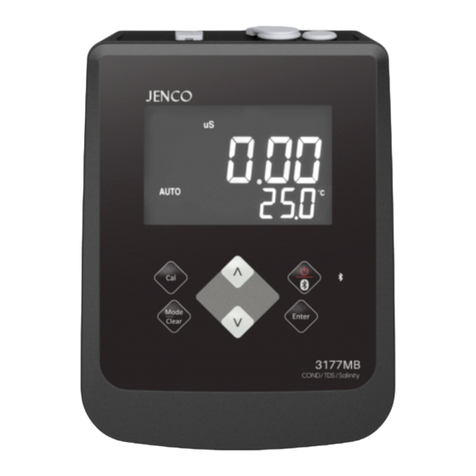
JENCO
JENCO 3177MB User manual

JENCO
JENCO pH610N User manual
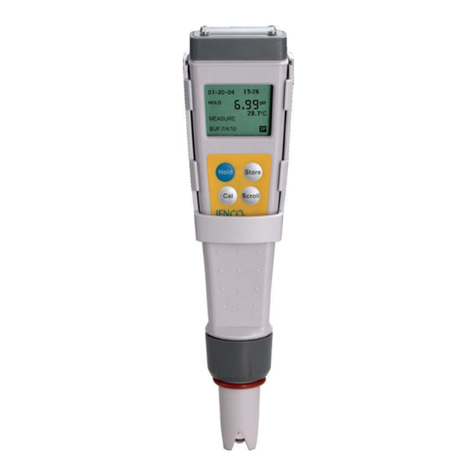
JENCO
JENCO VisionPlus pH 618 User manual
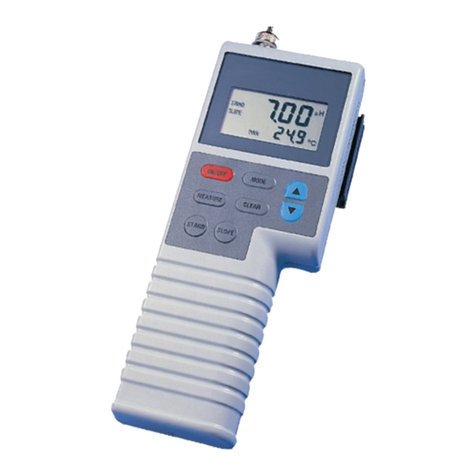
JENCO
JENCO 6230M User manual

JENCO
JENCO VisionPlus 3177 User manual
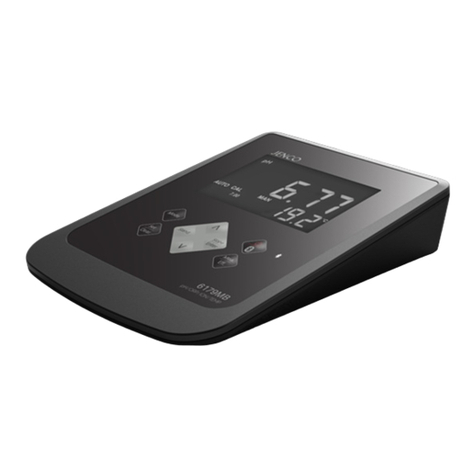
JENCO
JENCO 6179MB User manual
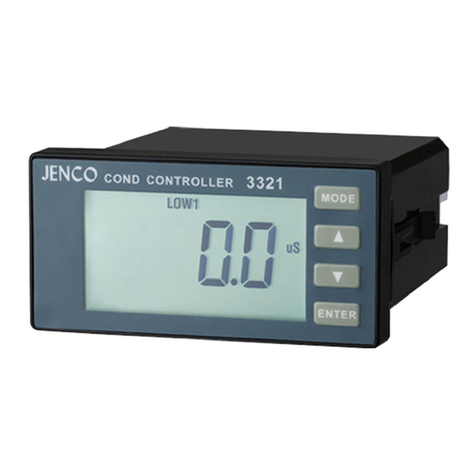
JENCO
JENCO 3321 User manual

JENCO
JENCO EC3840 User manual

JENCO
JENCO VisionPlus pH630 User manual
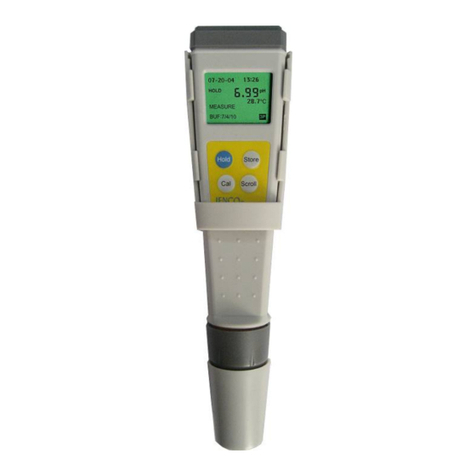
JENCO
JENCO VisionPlus pH618N User manual
Popular Measuring Instrument manuals by other brands
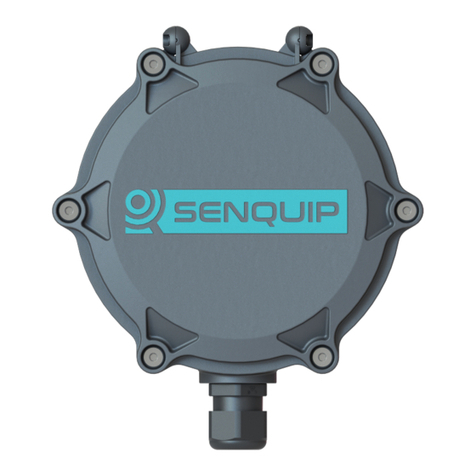
Senquip
Senquip ORB Series user guide

GHM
GHM Delta OHM LPPYRA06 operating manual
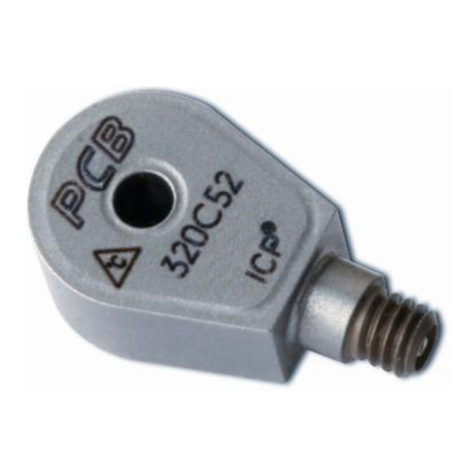
PCB Piezotronics
PCB Piezotronics M320C52 Installation and operating manual
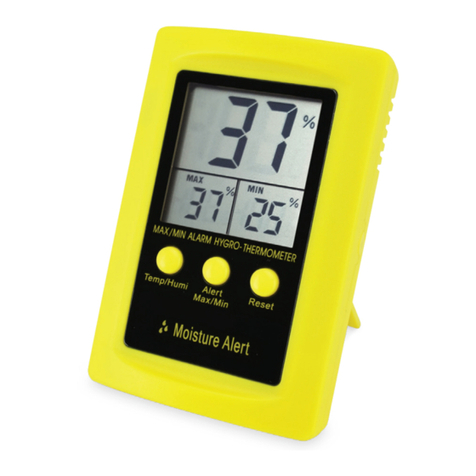
ETI
ETI MOISTURE ALERT operating instructions
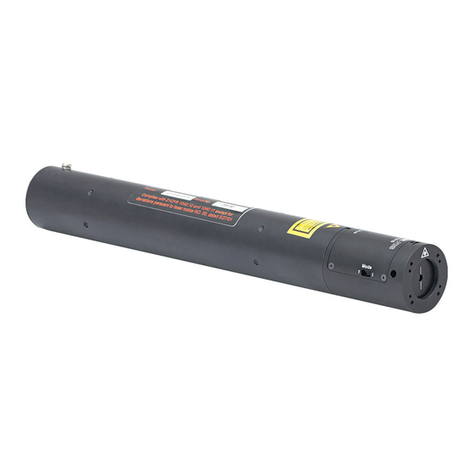
THORLABS
THORLABS HRS015 user guide
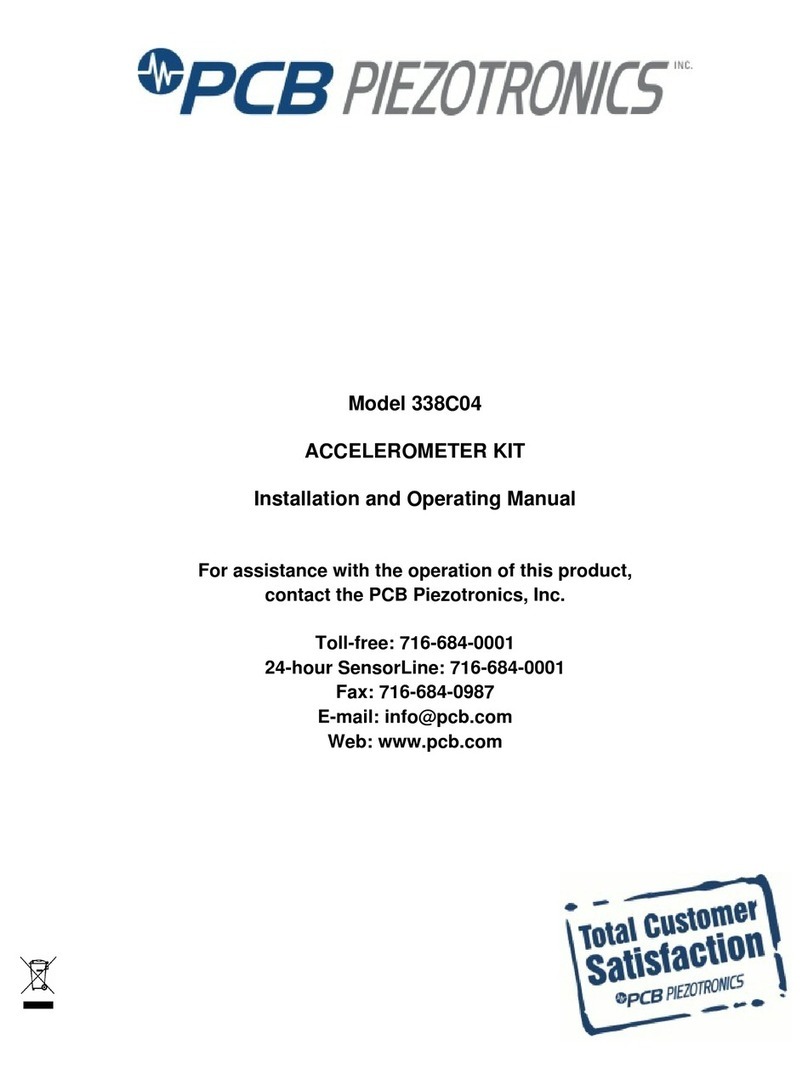
PCB Piezotronics
PCB Piezotronics 338C04 Installation and operating manual
